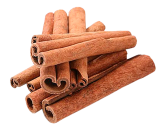Cinnamon is produced by cutting the stems of cinnamon trees. The inner bark is then pulled out and the woody parts removed.
There are two major kinds of cinnamon:
1. Ceylon cinnamon: known as “true” cinnamon.
2. Cassia cinnamon: The more common variety today and what people generally refer to as “cinnamon.”
Benefits
The unique smell and flavor of cinnamon are due to the oily part, which is very high in the compound cinnamaldehyde, responsible for most of cinnamon’s powerful impact on health and metabolism.
Cinnamon bark is proven for gastrointestinal (GI) upset, diarrhea, and gas, reduce spasms and reduce gas (flatulence). Cinnamon oil found in its bark is also used for boosting appetite; for infections caused by bacteria and parasitic worms; and for menstrual cramps, the common cold, and for flu (influenza).
Cinnamon might also raise blood flow. Cinnamon bark also constitutes of a chemical that might work like insulin to reduce blood sugar. Nevertheless, these factors require further study.
There are also ingredients in cinnamon bark called tannins that might help recover wounds quickly by acting as an astringent.
| Weight |
50 gm, 100 gm, 250 gm, 500 gm, 1000 gm
|







